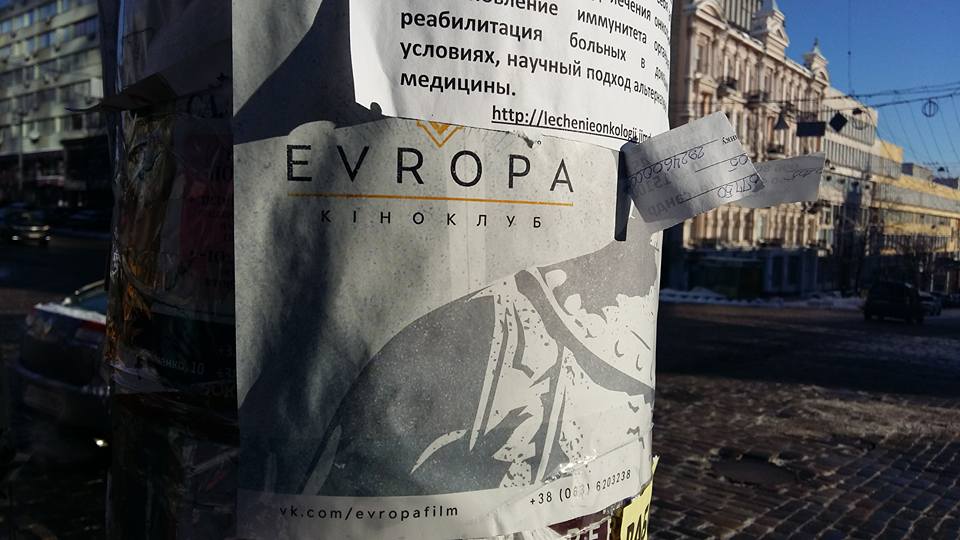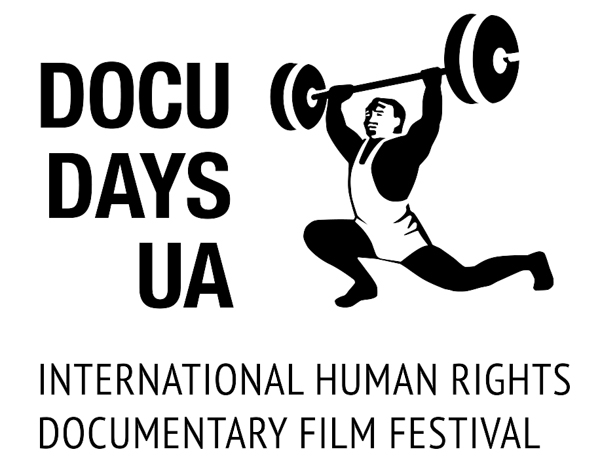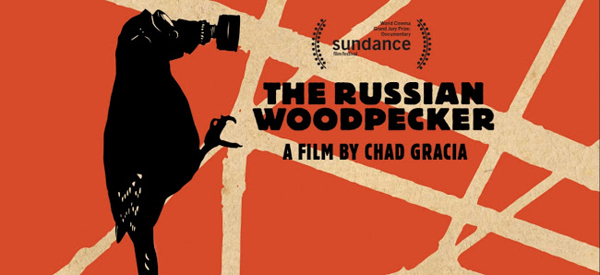Production Web
Meet with cultural actors in Ukraine
Site web / 7 interviews / mars 2017
A country of « confines » – as its etymology indicates – located at the confluence of Central Europe, Russia, and the Black Sea, Ukraine tries to assert its existence in a complex geopolitical context. If the stake is obviously mostly territorial, it is also cultural, in a nation that centuries have often condemned to blending into a larger entity.
In association with the French Institute, la fabrique documentaire offers, in the shape of a weekly review, an encounter with seven Ukrainian actors of cultural production. Publishers, producers, curators, gallery owners, festival organizers… In a renaissance nation with still unclear contours, they embody a new generation eager to forge links with the rest of Europe.
(also available in French version)
7. PAVLO GUDIMOV: ME GALLERY
Despite his youthful air Pavlo Gudimov is a predok, an ancestor. Yesterday member of the rock band Okean Elzy, now independent figure of the art world with his concept of Ya Gallery, « Me Gallery »…
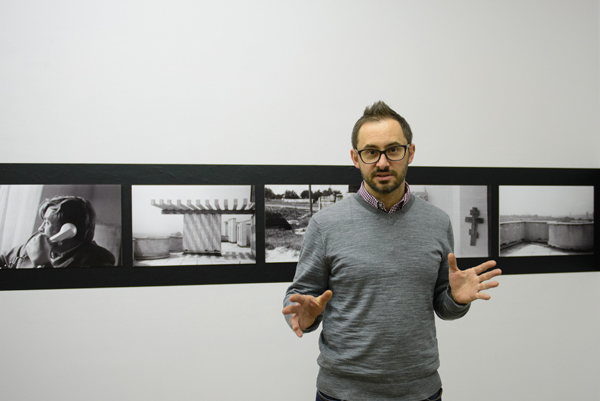
[Pavlo Gudimov at the Ya Gallery, Kiev, April 2017 – photo: Olga Ivashchenko]
Located since 2007 in the Podil district – the Lower Town on the banks of the Dnieper – the Ya Gallery and the accompanying projects, Ya Design, Artbook, Gudimov (around music), extend to Dnipro (formerly Dniepropetrovsk, the third Ukrainian city, in the east of the country) where Pavlo Gudimov set up a branch in 2010. But their influence lies far beyond that, on the rails of the Saatchi Gallery in London or in the nicknamed “pink city” of Toulouse (south west of France) for example. The project has been deployed in time and space for ten years.
Why settle in this district where industrial history crosses that of commerce? « It’s obvious. Here there is a successful mix between history and the contemporary. In the 19th Century, many painters came to settle there. Mohyla University is nearby. » In 1992, this ancestral university managed to renew itself thoroughly with a method of education more open to the world. A new line was emerging on the horizon. The times were suited. The youth was fired up, the old world tired out.
Flashback
To approach Pavlo we have to change focal length – in short, to expand our vision in order to better follow through his many lives the sinuous course of the cultural changes of Ukraine.
Born in 1973 in Lviv, then a renowned cultural centre, he is the grandson of an architect who practices photography. His grandfather plays for little Pacha – Pavlo’s nickname – the role of a conveyor: « He is the one who connects me to the modern art of the likes of Picasso, Fernand Leger … » In 1981 he begins to study French. He is trained as a landscaper. His entry into adulthood coincides with the moment when his country became independent in 1991. He left school with dreams of becoming a guitarist. He co-founded with three other members the rock band Okean Elzy before changing direction for Kyiv.
5 albums and 14 years later, Pavlo left the band (in 2005). « I had a career – behind and in front of me. At each demonstration we were listened to. But after the Orange Revolution, in 2004, I thought it was the perfect time to make other artistic dreams come true. »
« FOR ME, REAL CHANGE COMES FROM MY LIFE »
« What really interested me in my activity as a musician was meeting new people » always broadening horizons, deepening the mystery of relationships. “I appreciate when the territories mix. » Several times Pavlo uses the term mix. “This helps avoid isolation. This is foremost a new stage. The arts must interfere, cross and feed off each other. As the vanguards of the 1920s were able to do, the 1960s, via Khrushchev, which gave birth to a second vanguard. We are rich of all this. »
Pavlo Gudimov, in 2005, you are a public figure, playing in a famous band. You leave the group and two years later you open a gallery of contemporary art. Why?
Pavlo Gudimov: Actually in 2001, I had created the studio Ya Design, a multidisciplinary initiative in which various experimental designers were able to nurture artistic projects. At that time, there were many amateur works in the artistic field. One could compare that to the Sound System, with a lot of creativity, energy. After five years we thought that we should perhaps better structure all this and bring in a professional dimension. It was in this spirit that Ya Gallery Art Center was born, with the desire to give artists the opportunity to work with collectors.
However the artistic component was separated from the art centre. Ya Design is now part of the Gudimov artistic project of cultural exploitation in connection with architecture, interior design, landscape design, graphic design and web. Not to mention the edition, with catalogues that accompany the projects of the Art Center and its authors.
What does it mean to work independently in contemporary art in Ukraine?
For Ya Gallery, being independent means working without the system. Unlike France, for example, cultural structures do not have this tradition of working with the state. In fact, we are developing a form of patronage with private foundations. However since the opening in 2007 things have changed and I changed too. My position as a citizen has asserted itself and my social role is that of a manager of culture. Also we work for the Ministry of Culture by providing advice.
Do you have examples?
We work with the national art museums of Kyiv, Lviv, and with the art museums of other cities – ten in total. We accompany them in their reflections around their collection. We play the role of curator, museographer and we try to mix the eras. To build it all, we also work with private foundations. You know, change is possible in our country. Showing the energy that exists in contemporary art is also a social responsibility.
« CHANGE IS POSSIBLE IN OUR COUNTRY.
SHOWING THE ENERGY THAT EXISTS IN CONTEMPORARY ART
IS ALSO A SOCIAL RESPONSIBILITY »
The term « mixing » often appears in your statements: historical mixing about your establishment in the Podil district, mixing arts … Is it important to cross genres?
What makes the Podil district so rich is its historical sedimentation, from its heterogeneous populations – merchants, workmen, painters – to buildings of different styles that house offices, galleries, theatres, booksellers … We are located at this crossroad. Ya Gallery is conceived as a territory of communication that makes things possible. That’s why we work with many curators. This was the case for the exhibition devoted to the film by Sergei Paradjanov, Shadows of Forgotten Ancestors (1964), at the National Museum of Arsenal (Kyiv) with the Culture Museum Complex in 2016. It was both a cultural project on a cinematographic work that was filmed in the Carpathians and edited in the Dovzhenko studios in Kyiv and an artistic one through specific works that reinterpreted the masterpiece. This is an age we want to refer to, because in the USSR there was a period of revolutionary artistic change, with new forms of freedom. This is what we do, creating bridges to propagate the art to a larger audience. And this is not propaganda.
Interview in Kyiv and Paris by Sebastien Lecordier
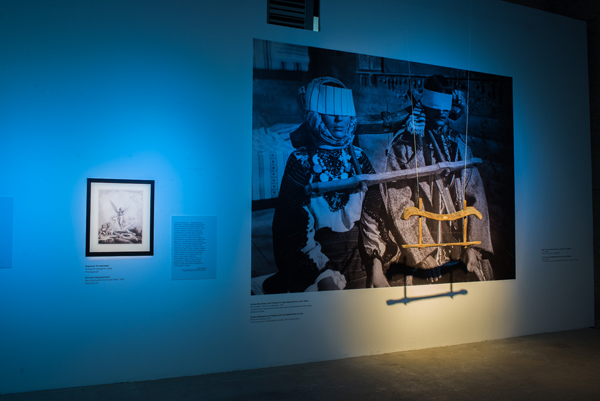
[Exhibition « Shadows of Forgotten Ancestors« , National Museum of the Arsenal, Kyiv, 23 March – 10 April 2016]
—
6. IVAN KOZLENKO AND OLGA ZHUK,
OLEKSANDR DOVZHENKO NATIONAL CENTRE
At the head of the Oleksandr Dovzhenko National Centre named after the renowned Ukrainian-Soviet filmmaker, Ivan Kozlenko and Olga Zhuk’s have a mission: to highlight the Ukrainian cinematographic heritage.
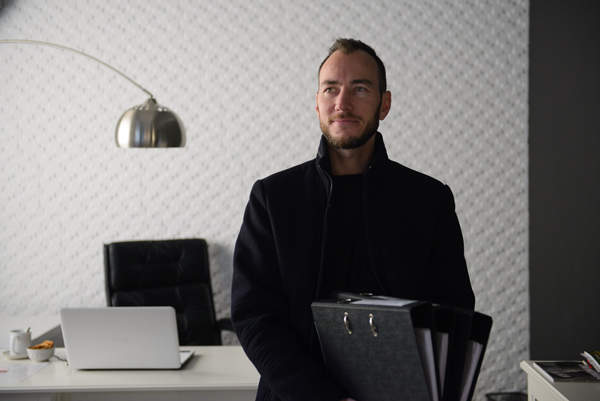
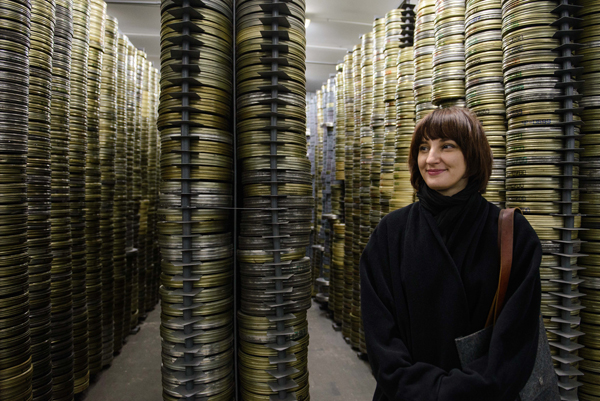
[Ivan Kozlenko and Olga Zhuk at the Oleksandr Dovzhenko National Centre, Holosivski, March 2017 – photos: Olga Ivashchenko]
In the suburb of Holosivski and its marked socialist architecture stands a vessel of bricks and tiles unlike any other. The film factory of Kyiv film was built in 1948 by Soviet prisoners and local workers, following plans of specialists from Leningrad (current St. Petersburg). Soon, the factory was named Oleksandr Dovzhenko (Alexander Dovzhenko), a mythical Ukrainian-Soviet director (Earth, 1930) and a tutelary figure of Kyiv’s cinemas.
During these decades kilometres of film have been produced in the chemical laboratory of the factory, which is still in operation although on a smaller scale. At the turn of the 2000s, the factory went down and in 2007 the State sold part of the buildings to finance the relocation of the national archives of Ukrainian cinema in the factory. It must be said that more than 5000 film rolls lie in this majestic factory.
In 2014 Ivan Kozlenko was appointed director of the Oleksandr Dovzhenko National Centre and his roadmap was to make it the major reference in Ukrainian cinema, an internationally renowned cinematheque. In times of economic crisis, while the public sector is only slowly awakening to cultural diplomacy, there is a long way to go. But Ivan Kozlenko, along with Olga Zhuk, his artistic director, has launched several projects, including a museum of cinema scheduled to open in the fall of 2017.
How does the Oleksandr Dovzhenko National Centre work?
Ivan Kozlenko: The Dovzhenko Centre was established in 1994 as the national archive centre of the Ukrainian film. We are a state institution, under the supervision of the Ministry of Culture. We employ 40 people: some workers have been working in the laboratories since the 1960s and master the chemical printing process of a film perfectly; there is also a research and promotion department and a very important patrimonial heritage.
Then the digital age became a reality. When I arrived as a director in 2014 I realized that the era of physical storage was coming to an end and that printing movies on film would no longer generate income. We had to reinvent ourselves to find a new identity and we decided to completely redesign this post-industrial environment to make it a major cultural project.
What will the future centre be like?
Olga Zhuk: It is the most important institution in Ukrainian history with regard to cinematography. It was decided to make it a more open cultural institution with an educational and experimental mission. The centre will accelerate its activities next autumn with the opening of a film museum, a bookshop, a place dedicated to live music, a school of photography …
Ivan Kozlenko: We have renovated much of the building, now we have to work on design. At the end of the renovation, in autumn, the museum will open in two large exhibition halls. We have the idea of renting our large roof space for concerts. It is a collaborative project because during the year 2014, that of the revolution, we did not have government funding and we had to solve all the problems on our own. We had to collaborate with new partners, such as the Festival of Contemporary Art, the Dakh theatre company of Vlad Troitsky, etc.
« OUR RESEARCH TEAM EXPLORES UKRAINIAN CINEMA »
Is the Dovzhenko Centre’s main purpose to reach the Ukrainian public or to open up internationally?
Olga Zhuk: We target the broadest possible audience with a special focus on children and teenagers. We will also promote Ukrainian film abroad by making copies for international film institutions. Our research team explores Ukrainian cinema. For example we do a lot of work around the silent film, which we put into live music events: it works especially well in Kyiv, but also in other Ukrainian cities.
Ivan Kozlenko: Unfortunately, we still have to deal with a lack of legislative framework. We are admittedly under the co-supervision of the Ministry of Culture and the Ukrainian National Film Agency (DerzhKino), but the law does not yet recognize us as a national archive. However a law is in preparation for the parliament, and we hope that it will be passed soon. In order to make this Ukrainian cinematheque work, we could follow the examples of what are doing the British Film Institute (BFI) in London or the Czech Film Archives in Prague. They have an interesting promotional activity abroad, which we would also like to develop.
Interview in Holosivski by Stéphane Siohan
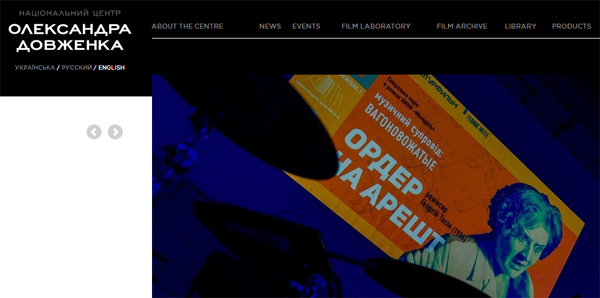
[Oleksandr Dovzhenko National Centre website – screenshot]
—
5. SVITLANA SMAL AND VICTORIA LESHCHENKO: THE DOCUMENTARY ACTION OF DOCUDAYS UA
Svitlana Smal and Victoria Leshchenko coordinate in Kiev Docudays UA: an international festival of documentary films devoted to human rights, whose action and ambition go far beyond the field of cinema.
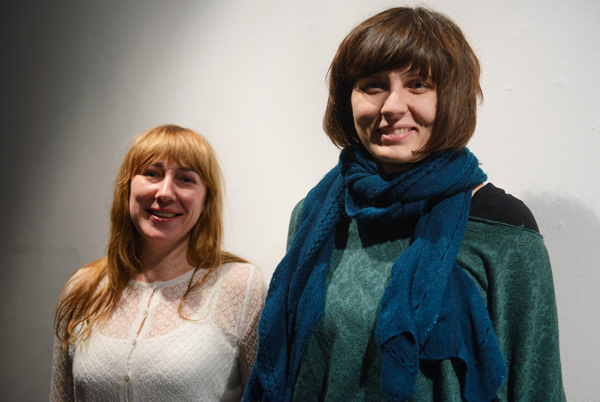
[Svitlana Smal (left) and Victoria Leshchenko in Kyiv, December 2016 – photo: Olga Ivashchenko]
What is the Docudays UA Festival?
Svitlana Smal and Victoria Leshchenko: Docudays UA is a documentary film festival devoted to human rights, a subject that leaves a fairly wide choice in programming. It has been held annually in Kyiv during the last week of March since 2003. The festival features four competitive selections, including one of short films and one of Ukrainian documentaries. The projections followed by debates, the heart of the festival, are accompanied by professional meetings and master classes with directors.
The 14th edition will take place from 24 to 31 March 2017. In 2016, the 13th edition, followed by more than 27,000 spectators in three cinemas in the Ukrainian capital, hosted 96 films, including 45 in competition, around the theme « Beyond the illusions ». In nearly fifteen years, the festival has gained international fame, with partnerships with institutions such as the Institute of Documentary Film (Prague), the Krakow Film Foundation (Cracow), Sheffield Doc/Fest , Dok Leipzig, CinéDOC-Tbilisi, The Guardian newspaper…
Our funding comes mainly from the Swedish International Development Cooperation Agency, as well as from the International Renaissance Foundation (Kyiv, member of the Open Society foundations network), the EU Delegation for Ukraine and National Endowment for Democracy (United States). The Ukrainian State Film Agency is also a reliable partner, whose contribution is set annually. Despite the difficult situation in the eastern part of the country, in 2016 it granted us 150,000 Hryvnia (around 5,300 Euros), in addition to its protection and important administrative support.
Finally, we have our own revenues, but they are quite low because our policy is to make the documentary as accessible as possible to the Ukrainians, which translates into sessions that are free or at very low cost (around 20 Hv, or about 0.70 €).
Beyond the organization of a festival in Kiev, how do you try to make the documentary accessible to Ukrainians?
We mostly work in two directions: production and review of documentary films dealing with Ukrainian reality, geographical and digital enlargement of documentary distribution. Docudays UA experiences first an important extension each autumn and during the winter: the festival then becomes itinerant in almost all the 25 regions (oblast) of Ukraine and this, as far as the Donbass (unoccupied part) which is in conflict and even in the Crimea under Russian control since 2014. In 2016, the Docudays UA Traveling Festival gathered more than 110,000 people in 238 cities and towns of Ukraine. In addition, we are federating a network of 200 cine-clubs dedicated to popular education for human rights. Last year, they welcomed nearly 50,000 spectators.
Our small team, about fifteen people in all, makes and also produces documentaries on the Ukrainian reality. One of them, Ukrainian Sheriffs (Roman Bondarchuk, 2015) recounting the tribulations of two improvised peacekeepers in a village in the south of the country, was a great success: Special Jury Prize of the International Documentary Filmfestival Of Amsterdam 2015, nominated to represent Ukraine in the competition for the Best Foreign Film at the 2016 Oscars. We also buy rights from Ukrainian producers and directors in order to be able to show their films for five years: to date we have a collection of some fifty documentaries. Recently we started to offer the theatrical release of some of these films, and the public has answered the call. Finally we have the online platform Docuspace.org where many of these films, which deal with human rights in Ukraine, can be seen for free.
“THE DISTRIBUTION OF DOCUMENTARY CINEMA
IS IMPORTANT TO BUILD A CIVIL SOCIETY IN UKRAINE”
How does this documentary action seem useful to you in Ukraine today?
At Docudays UA we believe that the production and distribution of these films is important to build a civil society: the least that can be said is that education about human rights, citizenship, political consciousness in the broad sense is not in the priorities of public action in Ukraine. But we believe in the popular education power of the documentary, in its emotional power, in its educational power, in its capacity to transmit knowledge and to create mobilization.
Interview in Kiev by Benjamin Bibas and Francky Blandeau
—
4. MARINA OREKHOVA, INDEPENDENT DOCUMENTARY PRODUCER
Producer of documentaries based in Kyiv, Marina Orekhova evokes the Ukrainian thriving audiovisual scene and its openness to the rest of Europe.
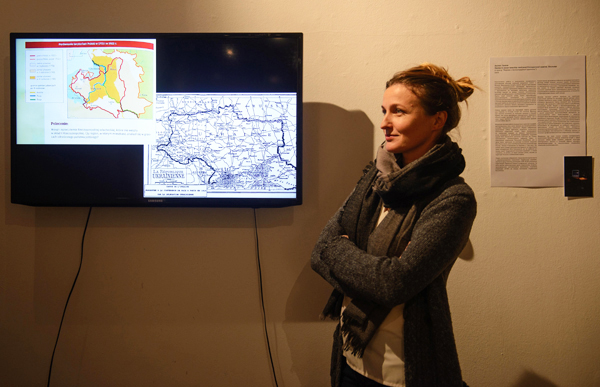
[Marina Orekhova in Kyiv, December 2016 – photo: Olga Ivashchenko]
Born in Kyiv in 1980, Marina Orekhova has practiced for almost ten years as an independent executive producer. Active in the field of documentaries, she puts her experience at the service of Ukrainian or more often international television productions. The Russian Woodpecker (Chad Gracia, 2015) a film about the causes of the Chernobyl nuclear disaster, first prize for international documentary at the Sundance 2015 festival, is among her latest works.
Previously, Marina Orekhova was for three years executive director of Molodist, Kyiv’s International Film Festival. Her current working partners are mostly delegated producers or filmmakers whom she met there. Hence the desire to make films, in its most concrete sense: « I am not the kind of person who has great ideas, rather one of those who make things work ». Her career and her profession have opened her to the vast world: unlike many of her contemporaries she has not made the move to go into a long exile. In the future she would like to leave the sometimes arid field of the documentary to approach the more creative and remunerative one of fiction.
What is the job of executive producer in Kyiv?
Marina Orekhova: In Kyiv as elsewhere, being an executive producer requires a lot of energy: you have to listen to the often impossible ideas of directors and above all be able to materialize them. In Ukraine, it is not simple for at least two reasons. On the one hand, the audiovisual economy is entirely focused on large-scale commercial productions. So, for small documentary productions, it is not simple: the material, the accessories, the lights … everything must be found with sole resourcefulness. On the other hand, relations with the authorities are complicated. In 99% of my film shoots, I work with foreign teams who have no experience of the Ukrainian administration and its heaviness inherited from the Soviet system. They need local people to get permits of all kinds, and that’s one of the important roles I have. In these conditions, producing ambitious documentaries is particularly exciting: their good implementation is always improbable, it depends only on your commitment and your creativity, and it is always a victory when a film shoot is successful!
What works well in Kyiv however is the quality of our technicians. They are well-trained, have had a good schooling and enjoy a cinematographic culture dominated by great figures such as the Ukrainian-Soviet filmmaker Alexander Dovzhenko (Earth, 1930) or Sergei Paradjanov, who filmed extensively in Ukraine (notably Shadows of Forgotten Ancestors, 1964). In general the audiovisual and cultural sector is bubbling in Kyiv: there is energy, curiosity, desire to do things, a society in demand for films and you have a great autonomy in your work. It is an excellent place to produce films when you are a young or middle-aged director.
“I WOULD LIKE UKRAINIAN POLITICIANS
OR ENTREPRENEURS
TO TAKE THE INITIATIVE
OF FINANCING SMALL ART CENTRES”
From your job, what is your view of Europe?
Since two or three years, if the Ukrainian audiovisual scene is flourishing, it is thanks to Europe. Ukrainian films are regularly selected at European festivals. Ukrainian authors, producers and directors benefit from the attractiveness of the European institutions for Eastern Europe: they can study at film schools in Poland or the Netherlands, obtain writing scholarships, and so on. We feel that Europe is open to us. In my specific job for example, Ukrainian producers need to train themselves to convincingly present a film project to donors … well just go see what happens in other European countries and learn! And these exchanges are still at their beginning. So I feel good in Kyiv today, personally and professionally: living in Kyiv allows access to all this openness.
In terms of cultural institutions, Europe is also a model: when one sees the German Cinematheque in Berlin or the French Cinematheque in Paris, the quality of their exhibitions and their media libraries, and especially the queues that form in front of their ticket offices early in the the morning on weekdays to see movies from around the world … One would say that Ukrainian cultural institutions are still far from this level of activity. Yet there is money in this country. I would like Ukrainian politicians or entrepreneurs to take the initiative of financing small art centres, cultural laboratories, galleries, so that all the creativity of young people can be expressed.
“KYIV IS A POLITICALLY DEPRESSING
BUT CULTURALLY EXCITING CITY.”
You talk about Kiev as a city open to Europe, bubbling with energy and creativity. Is it the Euromaidan effect?
Absolutely not; the events of Euromaidan in 2013-2014 certainly shook this country, it was an immense experience of freedom. But three years later we realised that everything we had fought, including corruption and the use of public institutions for personal purposes, was still there. The faces have changed, but the practices remain. From this point of view, Kyiv is a culturally exciting but politically depressing city. Because we already experienced this sensation after the Orange Revolution of 2004-2005 … except at the time, despite major clashes in Kyiv, there were no deaths. Nine years later, about one hundred people lost their lives in Maidan Square in February 2014. I hope – and we will ensure – that they did not die in vain.
Interview in Kiev by Sébastien Lecordier and Benjamin Bibas
—
3. MIKHAILO GLUBOKYI (IZOLYATSIA),
CULTURAL DISPLACEMENT
The story of Mikhailo Glubokyi merges with that of the Izolyatsia art centre: due to the conflict in eastern Ukraine, both moved from Donetsk to Kyiv.
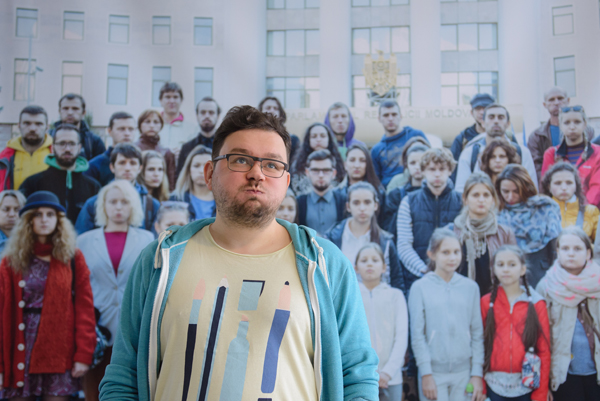
[Mikhailo Glubokyi in front of a photo of the Polish artist Alicja Rogalska in Izolyatsia, Kyiv, December 2016 – photo: Olga Ivashchenko]
On his Facebook page, Mikhailo Glubokyi presents his job with humour: technical information guru for the Izolyatsia Foundation, a platform dedicated to cultural initiatives. Mikhailo is a graduate of the Technical University of Donetsk in the Donbass region (in south-eastern Ukraine). He holds numerous positions within the foundation: coordinator, programmer, communication director. Izolyatsia has twenty-eight employees distributed between the platform and the Izone, a space spread over two floors dedicated to co-working and lab. The organization is flexible, light, with horizontal functioning and few hierarchical relationships. The energy of the place comes from the important interaction that exists between the internal and external members of the organization, such as artists in residence or local artists.
Mikhailo Glubokyi, 30, was born in south-eastern Ukraine, near Donetsk. It is when finishing his studies in Warsaw that he discovers the vitality of cultural centres and contemporary art. Back in Donetsk in 2011, he goes to the only place in the city where artistic, cultural, and citizen involvements mingle: Izolyatsia. Created a year ago by Luba Michailova, Izolyatsia is a non-profit, non-governmental organization. Luba Michailova’s father made a fortune in steel. It was with his legacy that she decided to create an art centre in the disused family factory. Very quickly, it joins the Trans Europe Halles network, which brings together 70 members in 28 countries, including Mains d’oeuvres in Saint-Ouen (suburb of Paris). In 2014 the centre is forced into exile and moved manu militari by pro-Russian separatists (to see what the pro-Russian paramilitary authorities of Donetsk thought in 2014 of Izolyatsia, see this video).
« Our main mission is
to preserve our industrial heritage by linking it
with the new digital, technological culture”
It is on the banks of the Dnieper in Kyiv that Izolyatsia lands. Reminiscence of Donetsk, the art centre also occupies a former factory, a shipyard this time. The industrial dimension was included in the specifications. Izolyatsia means « isolation ». At the time it was the type of material that was produced by the Donetsk factory. The industry of yesterday has become the heritage of today.
Inside this huge cube with greyish bricks three multifunctional floors, where any type of event is welcome: festivals, exhibitions, concerts, conferences, readings, workshops. The important thing is to create synergies between different actors, whether local, national or international.
Thus the exhibition « Blue Box. Common Places and Contemporary Artistic Practices » where international curators invite artists to respond to specific problems encountered in Kyiv, Minsk, Tbilisi, Warsaw and Chisinau. For example, Alicja Rogalska works in Chisinau, the capital of Moldova. Through photography and the video, she highlights a problem of general interest in Moldova: the difficulty of having access to drinking water. Installation: people drink the liquid without swallowing it and travel several kilometres to the Parliament. A commitment where art, culture are thought in connection with a social or political evolution. It is the whole point of Izolyatsia.
What interested you in the project developed by Izolyatsia?
Mikhailo Glubokyi: I arrived in Izolyatsia in 2011, so almost at the beginning of the adventure. In Donetsk it was the only place that showed contemporary art. I had to be part of it. Then, what interests me with the foundation is the way society is approached. The platform hosts artists, curators, but also start-up entrepreneurs. It creates bridges between these worlds and offers the possibility to share the experiences of everyone. When a person from a foreign country comes, they exchange with local actors. These actors then benefit from a new perspective, both on their work and on the world. In addition, there are always new ideas emerging. I have a special job. In fact I learn every day, which is rare.
How was the arrival of Izolyatsia in Kiev?
We were extremely lucky. A lot of people helped us. Some people came physically and participated in our installation. At the international level, we are followed by a community of institutions, artists who have brought to us much more than their support. They alerted the media. This solidarity, both inside and outside the country, has been beneficial. Social networks also played their role in organizing flash mobs. These were moving moments. All this asks an essential question for us, and we are still tirelessly asking ourselves: what should we do here in Kyiv?
What is the main purpose or mission of the foundation?
Our main mission is to preserve our industrial heritage by linking it with the new digital, technological culture. It must be borne in mind that this legacy is important, especially in the south-east of the country. Indeed, the history of this region, the Donbass, is industrial development. Until the beginning of the 20th century there were only small villages. And when people found out that there was coal, then iron ore, cities were built. Then there were the steel mills where most of the inhabitants worked for decades. Industry has shaped the landscape, bodies, and spirits. Today it is over but its mark remains.
One of the reasons of the conflict stems from the lack of information and the many difficulties in constructing reliable information. In this way it becomes difficult to establish a social dialogue. Although we are located in Kyiv, we still work in this area. Especially with programs related to education. It is one of our main lines of work: to make possible the development of the economy, culture and environment in order to open a space for dialogue.
« ONE OF THE REASONS OF THE CONFLICT
STEMS FROM DIFFICULTIES IN
CONSTRUCTING RELIABLE INFORMATION”
Do you think things are changing, evolving?
As I said, what I appreciate in my work is to have a greater understanding of social and economic issues and to consider possible answers to these problems. I am thinking, for example, of the inhabitants of Marioupol, an industrial port in the east of the country. In 2016 the inhabitants began to make art. Before the war, art did not intervene in people’s lives. It was too far away from them, from their daily lives. But today, new spaces dedicated to culture have opened up.
Interview in Kyiv by Sébastien Lecordier
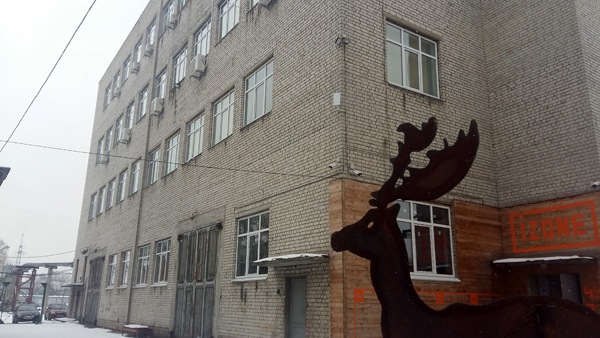
[The metal deer, the only vestige of Donetsk, placed at the entrance of Izolyatsia in Kyiv, December 2016 – photo: Sébastien Lecordier]
—
2. ANNA KRAVETS (VCRC):
RISING ABOVE THE « UKRAINIAN CULTURAL PRECARIAT »
« Arts, Knowledge and Politics »: interview with one of the very active volunteers of the Visual Culture Research Center (Kyiv).
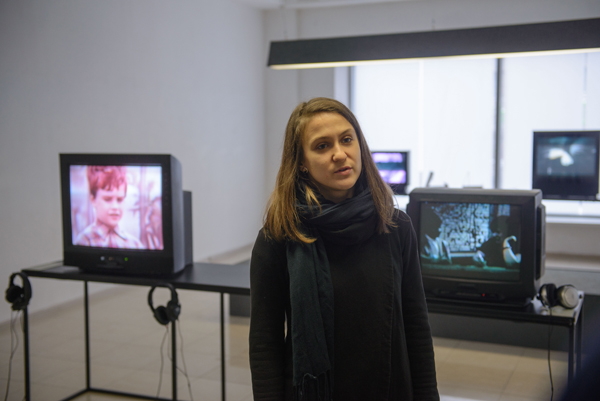
[Anna Kravets at the « Kinotron » exhibition, Visual Culture Research Center, Kyiv, December 2016 – photo: Olga Ivashchenko]
Volunteer member of the Visual Culture Research Center and translator, Anna Kravets, 28, « represents somewhat the Ukrainian cultural precariat, a situation shared by many young people today in the capital. » This does not prevent this young Francophone activist from participating in ambitious art exhibitions. She holds a master’s degree in Cultural Studies from the University of Kyiv, and has also obtained a master’s degree in Anthropology-Sociology-Comparative History obtained in 2015 at the EHESS Marseille: « I needed to take some distance to be less overwhelmed by the Ukrainian political context marked in particular by the events of Euromaïdan and the war in the Donbass.” In the offset innocent building where the gallery of the Visual Culture Research Center is located Anna Kravets precisely delivers her vision of the Euro-Ukrainian cultural dialogue.
What is the Visual Culture Research Center?
Anna Kravets: The Visual Culture Research Center was founded in 2008 in the Kyiv Mohyla Academy, historic university of the Ukrainian capital. We produce international conferences and debates based on an editorial line articulated around the concepts of Arts, Knowledge and Politics. We believe that these three concepts are linked because there is no political evolution without evolution of knowledge, which depend of the visual representations that are produced and conveyed. At first we functioned as a research centre organically linked to the university. But in 2012 the conservative administration of the university censored our exhibition « The Ukrainian Body », which forced us to leave the university to settle in a cinema. There, circumstances such as the attack by a far right group reacting to an exhibition on transsexuality especially, forced us to move again to a commercial premise that we are now renting.
Our approach is both comprehensive and prospective on contemporary society. We are always looking for the most appropriate medium to deal with this or that topic. Our « Kinotron » exhibition (November-December 2016) thus brings to light the work of Soviet experimental filmmaker Felix Sobolev from Kharkiv (northeastern Ukraine) to confront his vision of the future with our present world. Noticing a scientific acceleration in his time, Sobolev and his group wanted to create an acceleration of the imaginary: where are we with these accelerations today? Our exhibitions are free, we are open to all: this is for us an imperative in a country where, even if there is a tiny minority of very rich people, the minimum monthly income does not exceed 50€. We are also attentive to interact as much as possible with society, as we have during the events of Euromaïdan (November 2013 – February 2014) where we animated an « open university » to compare the various movements of insurrection in the world.
“Euromaïdan and ‘Nuit Debout’, even when they are over,
endure because they have produced
exchanges based on a common aspiration
to rebuild society”
You studied one year in France. To what extent do the Ukrainian and French political experiences seem to be linked?
I think that, like Ukraine, France is experiencing a period of great change. Ukraine was deeply shaken by the events of Euromaidan. More than a popular uprising against President Viktor Yanukovych, these events are part of a dynamic similar to that of the Arab Spring or the Occupy movements. They have been a sort of political factory with spontaneous workshops on human rights, social rights, women’s rights, human solidarity actions such as turns of duty in hospitals to protect the wounded from confrontations… This popular movement had encompassed a very large audience, taking inspiration from the presumed « European » values, i.e. a social Europe, a Europe of equality, even though most Ukrainians have never visited an EU country for lack of resources. And it is in Maidan this extremely inspiring event that started so many cultural and social initiatives that happen in Ukraine today.
In France it seems to me that you have experienced comparable events. There were the attacks of January and November 2015, the most intense political violence France has known since the war in Algeria. And millions of people on the streets, then a wave of commemorations on the Place de la Republique… which welcomed, almost continuously, a « Nuit Debout » movement of social experiments where for the first time the European hymn was played in the public space by a spontaneous orchestra. In Maidan as in Republique, there was also this very contemporary notion of « Media Boom », of a permanent connection on the web or television to these events. And above all, this emergence of a network and this permanence: Euromaïdan and, perhaps to a lesser extent, « Nuit Debout », are events which even when they are over, endure because they have produced energies and exchanges based on a common aspiration to rebuild society.
« The political situation is such
in Europe and in the world
that we are obliged to redefine
together what the common good is »
From a cultural point of view, what can Europe and Ukraine do for each other?
Ukraine can bring a lot to Europe because, thanks to its offset geographic position and particular political experience, our country produces new visions of Europe; it invites to renew one’s representations. Europe is today a little lost in its values, in the fantasy it projects of itself and society, but also in the place it holds in the world: historically a very open continent, it tries today to keep its borders in the East as in the South while retaining its power of attraction. At the same time Ukraine aspires to share European values to have a more decent standard of living and greater social justice, which would help free it from its dependence on the interests of the oligarchs and a of whole delictual political-financial network linked to the current Russian regime.
But Ukraine also needs Europe because it needs to structure the cultural initiatives that have taken place in Maidan at the institutional and financial level. Now, money lacks for culture in war-torn Ukraine: only the European Union, some of its members and a few other players are investing money in it. But we should not see this money only as a help to young Ukrainians wanting to experiment in the cultural field. This goes further: we urgently need to articulate these experiments and link them by projecting a more general social fantasy, in Ukraine as in Europe. The political situation is such on our continent and in the world that we are obliged to redefine together, on the basis of a research both artistic and not on the meaning of the experiences we are going through, what the common good is.
Interview in Kyiv by Sébastien Lecordier and Benjamin Bibas
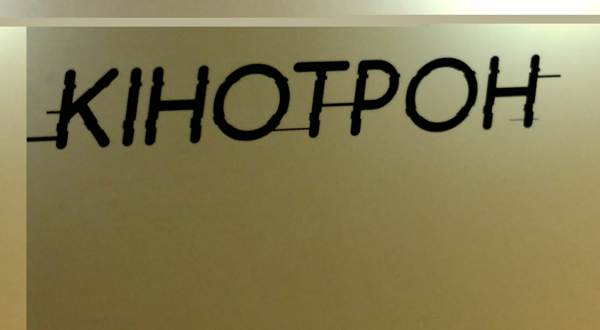 [Exhibition « Kinotron », Visual Culture Research Center, Kyiv, December 2016 – photo: Sébastien Lecordier]
[Exhibition « Kinotron », Visual Culture Research Center, Kyiv, December 2016 – photo: Sébastien Lecordier]
—
1. IRENA KARPA, YOUNG FACE OF UKRAINIAN CULTURAL DIPLOMACY
From Paris, the writer and actress of Ukrainian diplomacy Irena Karpa tries every day to hoist the cultural colors of her country.
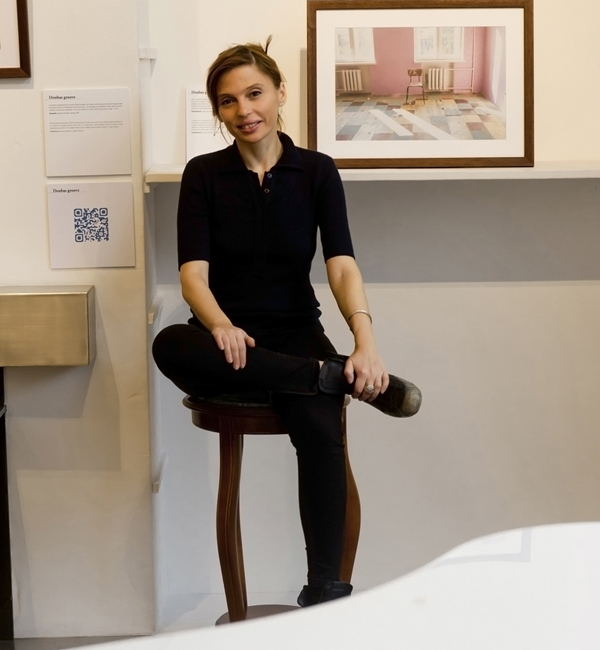
[Irena Karpa in Paris, December 2016 – photo: Patrice Bouvier]
December 2015. The First Secretary of the Cultural Service of the Ukrainian Embassy in Paris – it is her official title – details the photographs of Natalia Liubchenkova and her exhibition Donbas Groove, “because there isn’t only war in Ukraine, there are also people who resist, who organize their lives. Like this former miner, Ivan, reconverted to an organic farmer.” A graduate of the National University of Kiev, Irena Karpa isn’t one to bite her tongue: « With this war in the Donbass we separate psychologically from Russia. »
Born in 1980 in Cherkassy, Ukraine, a town on the banks of the Dnieper River, 200 km south of the capital, Kiev, Irena Karpa traveled extensively. In 2003, she settled down in Indonesia, wrote her second book and taught at a local university. She took the opportunity of immersing herself in a new lifestyle and of gathering experience, her leitmotiv.
Generation Maïdan
« Having entered the game of diplomacy without any support » Irena speaks fluent English and clear French, like many of her young compatriots. She speaks with this touch of irony which also gives spirit to her writings, eight to this day. « After the events in Euromaïdan (November 2013 – February 2014), many people from the civil society entered politics but their bellies became as big as the system was corrupt. »
For Irena, this revolution allowed many people to realize that they were Ukrainian. There has been a desire for greater independence. « There is now a desire to hear more Ukrainian music, to speak Ukrainian. The fact of being identified in a positive way with everything Ukrainian is a step towards freedom. »
“The fact of being identified
in a positive way with everything Ukrainian
is a step towards freedom »
How did you come to take responsibility for cultural affairs at the Ukrainian embassy in Paris?
Irena Karpa: Before taking office, in December 2015, I often presented my books abroad. I had great difficulty in understanding how Ukrainian culture was presented and represented. For that reason, I went to offer my services to the Ministry of Foreign Affairs to work in Paris. After the events in Euromaïdan and the dismissal of President Viktor Yanukovych, it became possible for people from civil society to get involved in the affairs of the country.
In what political context do you perform your duties?
To be quite frank, it’s complicated to get money from the state and it’s even more complicated to know where the money comes from when it’s private. We normally have a budget to enhance the image of Ukraine. But until 2016 in any case, it is so weak and the administrative functioning is so far away that I am unable to pay for a plane ticket or a hotel room. That is why I have to look for other sources of funding.
Yet there is nothing better than cultural diplomacy to represent in a positive way the image of a country. If Ukrainian statesmen understood what is being played here they would fund more and better, but few oligarchs want to do this. Russia has understood it very well. It invests in soft power, as is the case with the exhibition « Kollektsia! » which is currently held in Beaubourg (until March 27, 2017). However there is a high quality Ukrainian artistic and cultural scene that I would like to help discover, to show.
What is the role of a Ukrainian cultural diplomat in a capital such as Paris?
My role is to present the cultural actions of my country in France. To this aim we organize concerts, exhibitions, and festivals. We use every opportunity to enhance the image of Ukraine. For my part, I want to show two things: that Ukraine is a European country, and that Ukrainian contemporary art, poetry, literature, music and culture do exist. Our artistic choices are based on the quality of the works.
What are your goals?
From a general point of view, I want to establish a system of cultural exchanges between our two countries. It works very well with Germany: I, myself, got a scholarship to go and reside in this country. And when you come back, you have gained experience.
That is why I want to create a scholarship for international translators working on Ukrainian literature. It is important that translators travel to Ukraine to understand what reality the author is referring to. They have to experience it.
Another area of work for me is to get Ukrainian publishers and international businessmen to meet, because it is very complicated to receive money from the Ukrainian state. This would thus bring Ukrainian artists and writers, among others, here in France.
Finally, I would like to present to the Palais de Tokyo 25 years of Ukrainian artistic scene in a lively and convivial setting: with local cuisine and a festival of Minimal Techno.
Interview done in Paris by Sébastien Lecordier
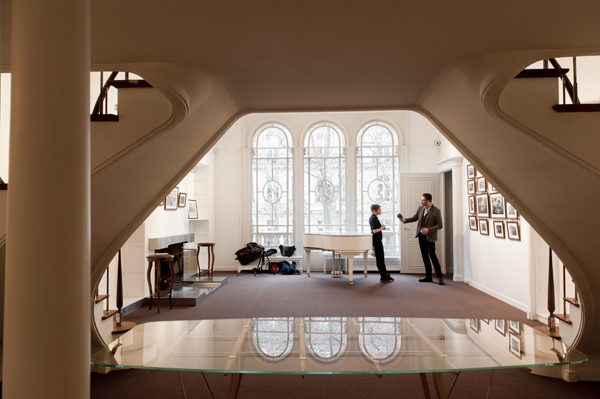
[Irena Karpa and Sébastien Lecordier at the Ukrainian Cultural Center in Paris, December 2016 – photo: Patrice Bouvier]
[Background photography: Kyiv, December 2016 – photo Sébastien Lecordier]
Coordination
Francky Blandeau
(French Institute)
Texts
Sébastien Lecordier
Benjamin Bibas
Stéphane Siohan
Photographs
Olga Ivashchenko
Sébastien Lecordier
Patrice Bouvier
Translation from French to English
Auriane Biron
